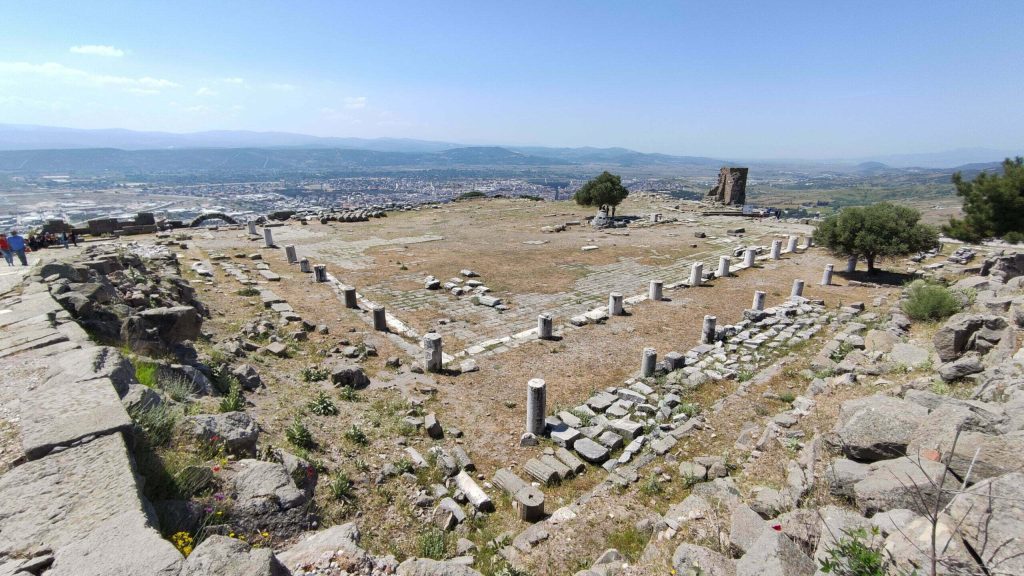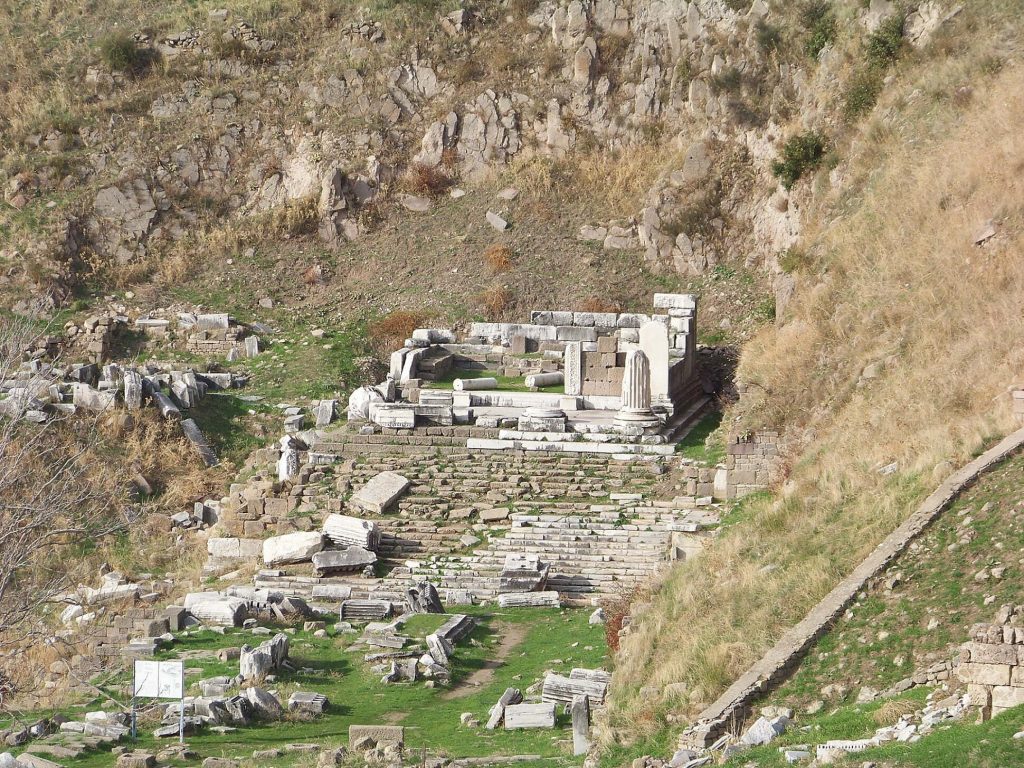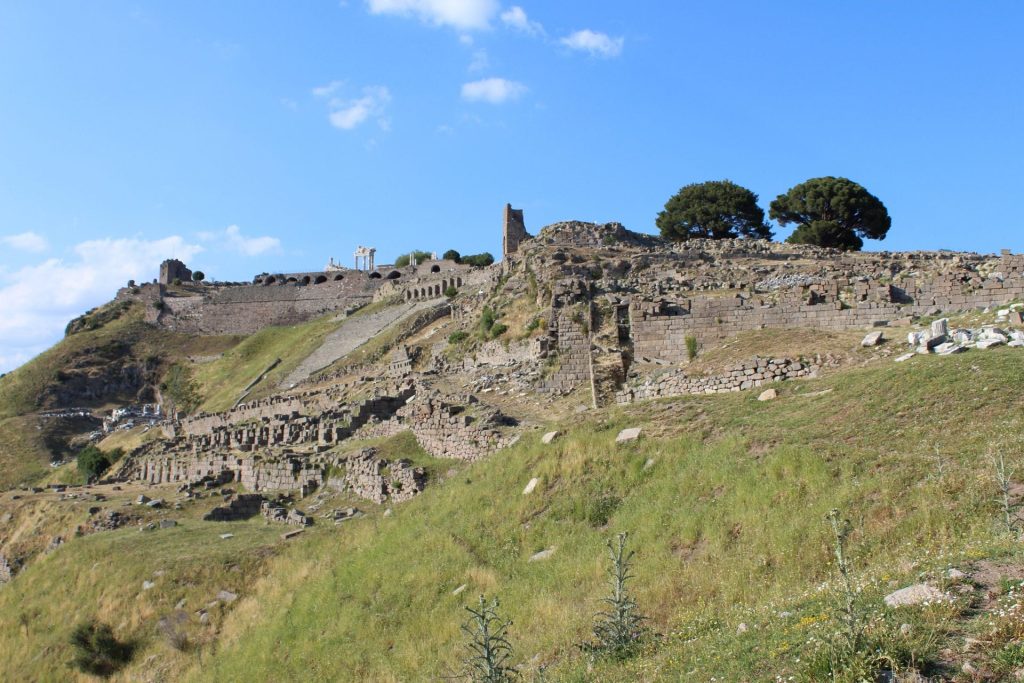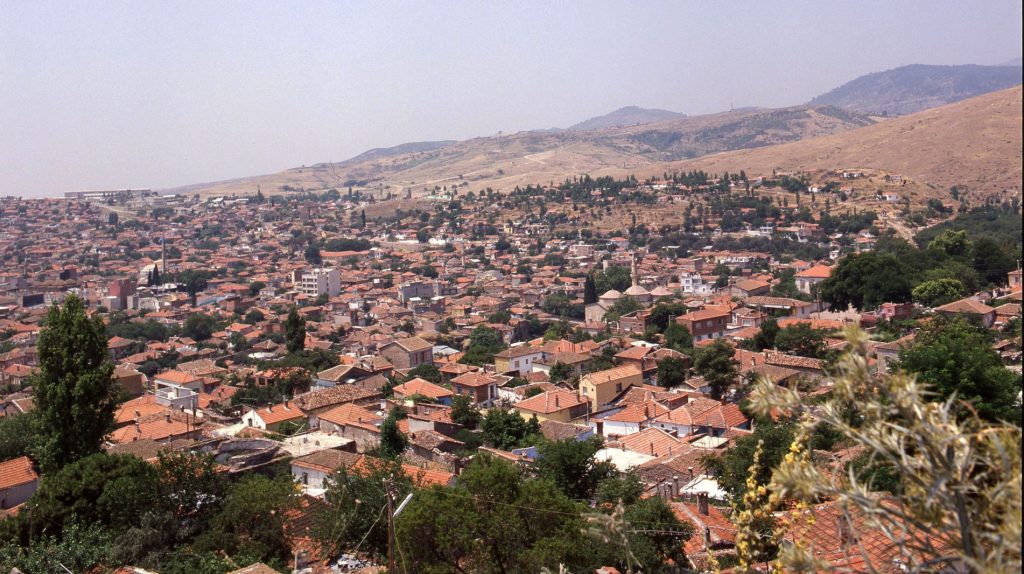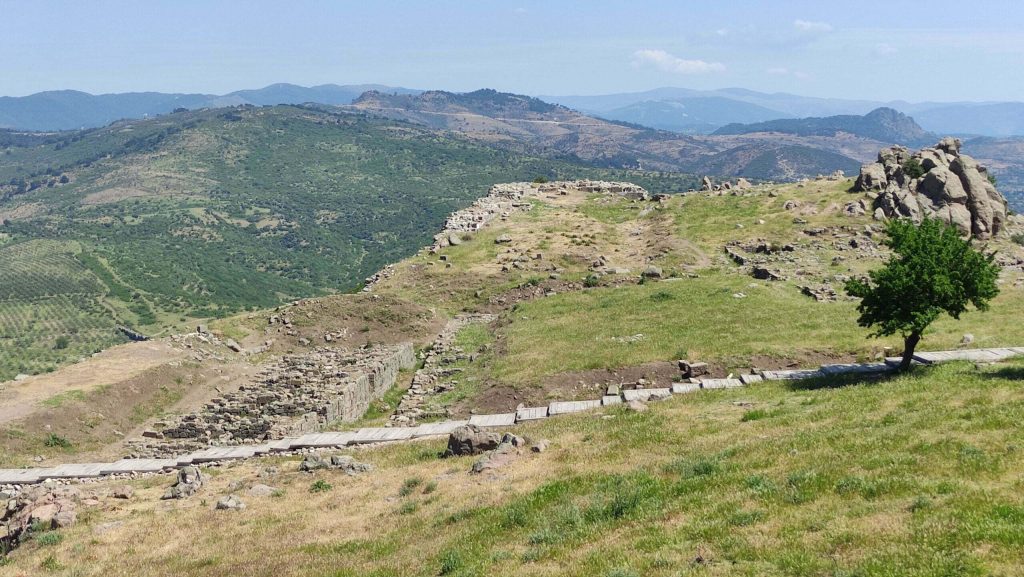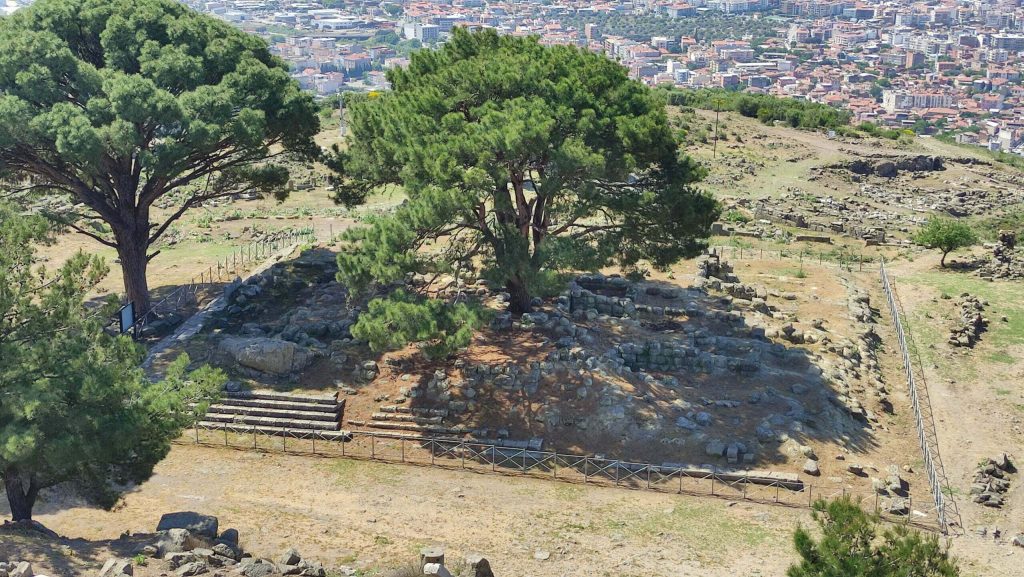The Acropolis of Pergamon
Pre-Roman History of Bergama
Findings such as stone axes and cutting stones discovered in archaeological excavations indicate that the history of Bergama and its surroundings dates back to prehistoric periods. In the region, while the permanent traces of the Pelasgian Culture, living on the western side of Anatolia around 4000 BC, are visible, it is known that between 3000-2000 BC, the Luwians had cultural influence and dominance. During the period when Hittite rule extended to Western Anatolia around 2000 BC, the region was called ”Assuva”. At the end of the 13th century BC, the western cities of Anatolia also supported the 10-year-long Trojan War. During these wars, an Achaean fleet mistakenly arrived at the shores of Teuthrania in Bergama, where Telephus fought with Achilles, and the wounded Telephus was healed with the rust of Achilles’ spear and had to show the way to Troy. As a reward for his help, Telephus was allowed to establish the port of Elaia as a base under the command of Athens. To end the Trojan War and capture the city, Neoptolemus, the son of Achilles, who was killed by Memnon, a commander in the Trojan War, participated in the war, showed great heroism, and eventually Troy fell, and peace was made.
According to a legend, Neoptolemus and his son Pergamos came from Greece to Anatolia, took possession of the city after killing King Areios in a duel, seized the kingdom, and named it after the Acropolis Hill. The name Bergama is thought to have originated from Anatolia because it means ”high hill/slope” in Hittite (Pergamos), ”city” in Ahraco-phrygian (Bergam), and ”mountain/hill” in Luvian. The Aegean migrations starting around 1200 BC led to the collapse of Assuva and the beginning of Hellenization. The earliest finds from the written period in the Bergama Acropolis, such as the 9th-century BC vase, 6th-century BC ceramics, and female statues, date the history of the area back to the Archaic Period. Following these early historical settlements, the emergence of the Lydian State is parallel to the emergence of cities such as Ionia (the Aegean coast of Asia Minor), Aeolis (the northern coast of the Aegean between Izmir and Edremit), and Greater Mysia, including Pergamon (the northwest of the Aegean). It is known from Homer’s Iliad that the mention of the name Lydia preceded the Mysian society. The Lydians, desiring control of the trade-based economy, attempted to prevent the strengthening of Greek cities, and prevented the Kimmerian attacks and the passage of the Medes to the western side of Anatolia. During the time of Croesus, called Karun, the mines between Bergama and Atarna were operated, the King’s Road connecting the Aegean to Basra was built, paid soldiers were gathered because no one wanted to serve in the Lydian cities in prosperity, but Persian Cyrus, called Cyrus the Great, came and ended Lydian dominance in the region in 546 BC, establishing the Ionian Satrapy, which included Aiolis. Among the classical period finds corresponding to the Persian rule period are marble votive reliefs depicting Zeus and Artemis. In 334 BC, Alexander the Great ensured the withdrawal of the Persians from Bergama, left one of his generals here to ensure the security, control, order, and protection of the spoils captured in Western Anatolia while going to Iran.
Kingdom of Bergama
In 301 BC, with the Battle of Ipsos, Lysimachus, who ruled in Thrace, captured Bergama and turned it into a military base. In 281 BC, Seleucus, the king of Syria, defeated Lysimachus’ army in Sardis and established the Kingdom of Bergama in 283 BC. During this period, the walls of Bergama were strengthened, and construction activities were carried out on the Acropolis. Later, Eumenes I, who came to power, declared Bergama’s independence by defeating Seleucus, and expanded the city’s borders to the Gulf of Edremit. During this period, the first strike in history was seen, and a contract was signed between mercenaries and Eumenes I. In addition, importance was given to science and art; decisions regarding governance were made, and a council of five judges ruling Bergama was established. After Eumenes I, his successor was Attalus I (241-197 BC), a powerful warrior and skilled diplomat. Attalus was hailed as a hero by the people for his repeated victories against the Galatians. A statue depicting Attalus on horseback killing enemies was erected in front of the Temple of Athena on the Acropolis, and monuments and inscriptions were erected around the temple. During this time, Bergama also became the first state to establish friendship with Rome, and also formed an alliance with Rhodes, which had a powerful navy. In 201 BC, King Philip of Macedonia attacked Bergama, failed to overcome its walls but destroyed temples and statues, and entered the Asclepion and damaged it. Due to constant attacks from states such as Syria and Macedonia, Athens, Rhodes, Bergama, Egypt, and some small states asked for help from Rome and formed a coalition of states. Thanks to the aid it provided to Athens, Attalus I also gained power and respect there. In 198-199 BC, Rome facilitated the withdrawal of the Syrian army that attacked Bergama. After ruling for 44 years, Attalus I died in 197 BC, and was succeeded by his eldest son, Eumenes II. Like his father Attalus I, Eumenes II also maintained close and good relations with Rome and allowed Rome to penetrate Anatolia without posing a threat, thus establishing a mutually beneficial relationship. Eumenes established the world’s largest and most famous library in Bergama after Alexandria, valued science, and became one of the last shining places of Hellenism. Also, when Egypt restricted the sale of parchment paper to foreign markets, parchment paper made from sheep, goat, cow, and deer skins was also found in Bergama. Despite Rome’s withdrawal and cessation of support, Eumenes II also earned the title of savior with the victories he won against the Galatians. After ruling for 38 years, Eumenes II, who died in 159 BC, had a very bright period for Bergama. He expanded settlement and urbanization from the foothills of the castle to the plain and built the third walls of the acropolis. II. Attalus, who showed his loyalty and respect to his brother during Eumenes’ time, succeeded him and continued his policy towards Rome and against Rome. Before his death, II. Attalus realized that it was inevitable for Rome, which had conquered Greece, to also conquer Anatolia, and began preparations for Bergama to become a satellite of Rome in a peaceful manner. The king had a harbor built for Ephesus, a stoa east of the agora in Athens, and statues of gods were made in various parts of Bergama, including the Temple of Athena and different regions of the castle. In 138 BC, III. Attalus, the illegitimate son or adopted son of II. Eumenes, who died after his death, took over the throne, and after poisoning II. Attalus at the age of 33, who ruled for 4 years, he became the ruler of Bergama. III. Attalus, who was not trained as a head of state, was interested in biology and became a king who produced various chemicals such as drugs, poisons, antidotes, and ointments, and tested them on people, declared insane by the Romans. After winning the victory in the Bithynia attack with the support of Rome, his statue was erected in the Asclepion, and thanks to his knowledge of pharmacy and medicine, the Asclepion was named after the king. After the deaths of his mother Stratonike and his wife Berenice, his situation deteriorated, he became ill while building a monumental tomb for his mother, died, and bequeathed Bergama to Rome. While this situation caused confusion in the city, Aristonicus, the illegitimate son of II. Eumenes, born to a woman from Ephesus, claimed the throne and tried to overthrow the feudal order by offering equal rights to society and managing a classless state. Aristonicus, whose supporters increased gradually, became a threat to Rome and fought with Aristonicus with the help of cities such as Byzantium (Istanbul), Halicarnassus (Bodrum), and Mylasa (Milas), but he was defeated. Rome, which attacked for the second time in 130 BC, won the war this time, killed Aristonicus, who ruled for 4 years, and began to dominate the Eastern Mediterranean.
During the Roman Period in Bergama
In 129 BC, the Roman consul M. Aguillius, along with 10 senators, came to Bergama to establish a new administration and determine the boundaries. In accordance with the will of III. Attalus, the state land of Bergama, the most famous city of Asia with 12 ethnic groups, was annexed to Rome under the name Provincia Asia, thus the first province of Rome in Anatolia was established. There were great injustices in Rome’s administration, the governors assigned to its sphere of influence committed corruption, and the people were burdened with high taxes. Aguillius had roads built from Ephesus to Bergama for the regulation of administration and military affairs, and from Sardis to Tralles, connecting to Izmir and reaching coastal cities. During this period, Phrygia was also annexed to the Asia province with its capital in Ephesus, and Bergama lost its capital status and became a provincial town. Royal private properties were turned into state land, production sites were closed, and only mining operations were allowed. Under the pressure of Rome, the oppressed Anatolian people sought help from King VI. Mithridates of Pontus, who, taking advantage of Rome’s involvement in the Italian civil war, cleaned the cities in Anatolia of the Romans and killed Roman businessmen and merchants living in Bergama. The Roman commander Sulla, after the civil war, returned to Anatolia and began to reclaim the Anatolian cities. In the 1st century BC, Rome began to dominate not only Anatolia but also the eastern Mediterranean. Octavianus, who put an end to the Republican era, took the title Augustus, opened the way for 400 years of peace and prosperity in Bergama in 31 BC, and had a statue erected in the Temple of Athena. After the death of Augustus in AD 14, his son Tiberius became emperor. During these periods, there were major earthquakes, and Bergama, like many cities, was damaged. With the regulation of the administration, Bergama began to rise again, and Emperor Trajan (AD 98-117) had a magnificent temple built on the Acropolis, with giant marble columns that are still restored today. Emperor Hadrian (AD 117-138) also had important buildings such as Gymnasium/Stadium and Amphitheater built on the Bergama Acropolis. The statue resembling Hermes, which is now in the Bergama Museum, was placed in the Asclepion Library at that time. Marcus Aurelius (AD 161-180) built a small temple on the Acropolis for his wife Faustina. It can be understood from the inscription on the terrace of the Zeus Altar how the plague that broke out in 166 AD affected Bergama: ”O great god Zeus, along with Asclepius and all the gods, drive away the plague that struck the city.” After the plague, Emperor Septimius Severus became emperor, and after him, his son Caracalla (AD 211-218) had an accident while returning from the Thracian Campaign, was healed in the Asclepion, and as a gratitude, had a marble temple built for Dionysus on the terrace of the theater in the acropolis. The emperors of the 1st and 2nd centuries reshaped the city in and around the Acropolis with the construction activities they undertook and the art pieces they commissioned.
Christianity in Bergama
After the crucifixion of Jesus in AD 34, the Virgin Mary and the apostles came to Ephesus, and churches were built in seven Asian cities, including Bergama, and Christianity began to spread rapidly in the Aegean. The people of Bergama, who had difficulty breaking their attachment to the old gods, experienced another major earthquake, religious and natural collapses, and began to cling to Christianity, and by the end of the 2nd century, Bergama became a Christian city. With the Edict of Milan in 313, Constantine the Great accepted Christianity as the state religion.
Bergama in the Byzantine Era
The Roman Empire was divided into Eastern Rome (Byzantium) and Western Rome in 395 AD, and Western Rome collapsed in 476 AD. The country was divided into two general governorships and 64 provinces. During the time of Justinian, pagan buildings and temples were destroyed, and churches and monasteries were built in their place, and the parts of the Zeus Altar were used in strengthening the upper city walls. Bergama was attached to the archbishopric of Ephesus, and Byzantium gradually became easternized, and factionalism, religious debates, fights, heavy taxes, and war losses began to undermine Byzantium. Arab raids began in Anatolia in 651 AD, and a large Armenian colony migrated to Bergama, and in 716 AD, an Arab army led by Abdul Malik plundered Bergama.
